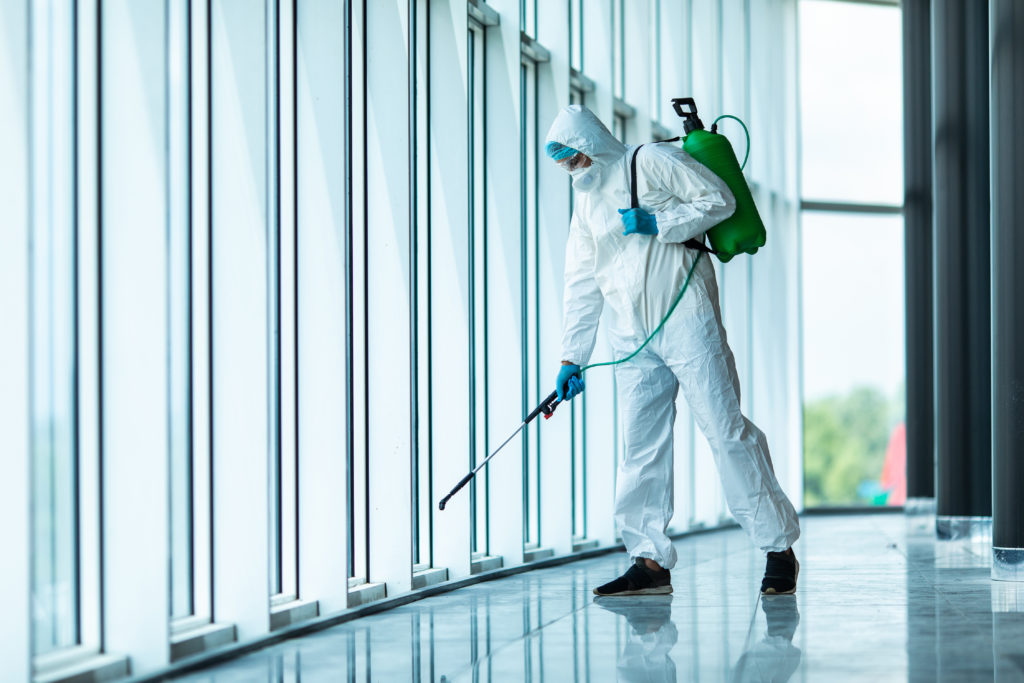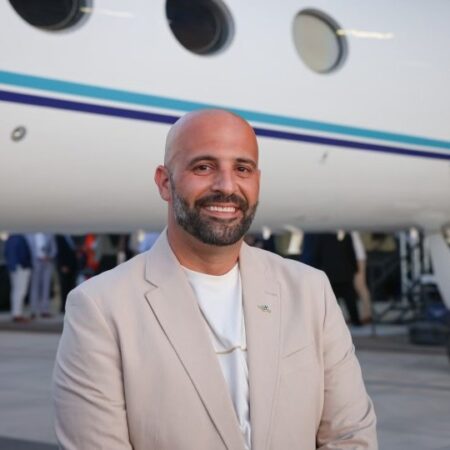Airports and FBOs are reimagining every aspect and touchpoint of their operations to ensure a clean, safe and healthy environment for their clients. But many are grappling with the dilemma of if it is possible to make these changes without spoiling the luxurious atmosphere FBOs and private airports are renowned for.
Almost a year on from when the devasting pandemic began to spread across the globe, sectors everywhere have had to adapt and use new technologies to ensure they can return to a new normal as quickly as possible.
Although business aviation was not immune to the impact of the pandemic, many FBOs have been operating in some way during this period. Staff have been practicing social distancing, wearing masks and following health guidance from their respective governments, hand sanitizers can be found on every flat surface and deep cleaning of all areas has increased. However, there is an argument that this still isn’t enough the slow down the virus.
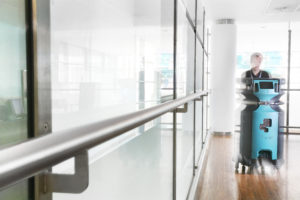
“Individuals can minimize their potential exposure by maintaining good hand hygiene and being careful not to touch their face and mask until they have thoroughly washed their hands. But it is not enough on its own,” says Tautvydas Karitonas, R&D manager from decontamination specialists Inivos, who is an expert in infection control.
“It is essential that cleaning staff and cabin crew whilst on the aircraft take proactive steps to mitigate risk for high touch point areas. At the start of each day, they should complete an assessment of all potential transmission risks and schedule regular, proactive decontamination to eradicate pathogens.”
The National Air Transport Association published guidance to FBOs and other business aviation ground handlers in March to help them manage risks and take extra safety precautions during the Covid-19 pandemic. The document describes operational steps management should take to minimize the chance of infection spreading to facilities, as well how to quarantine and the best practice for cleaning aircraft. Suggestions include ensuring individuals wear rubber gloves when cleaning and disinfecting the facility and the surrounding areas. The guidelines also state that disinfectant / antiseptic solutions should be applied hourly to high-risk, high-traffic areas and items. Along with following the guidance from the NATA, many FBOs have also developed their own updated cleaning standards since the outbreak.
“In March we introduced our CleanCheck Standard,” says Scott Cutshall, senior vice president of business operations for USA-based aviation services and FBO provider Clay Lacy. “It was developed by a cross-functional team of experts across our FBO, flight operations, facilities, inflight service, and maintenance departments. This standard was later certified as meeting the NATA Safety 1st Clean standard developed which has been accepted by FBOs across the country.”
Chiara Dorigotti, CEO of SEA Prime in Milan, Italy said, “We have provided staff with anti-contagion protective devices and have introduced protocols for deep cleaning and sanitizing of spaces and surfaces, including the installation of sanitizing gel dispensers in our terminals.”
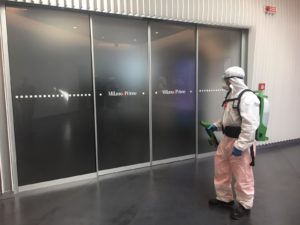
doors help to reduce the risk of transmission
“Airports and aircraft have social distancing and manual cleaning measures in place to demonstrate that they are a safe and hygienic environment to be in. However, as human cleaning can leave pathogenic micro-organisms behind by unintentional but unavoidable human error, more robust measures are required to ensure the risk of viral contamination and spread is kept to an absolute minimum,” says Karitonas.
Keeping a distance
“Social distancing is one of the most effective ways of limiting viral spread in public spaces, the SARS-CoV-2 micro-organism – which causes the Covid-19 virus – can survive for as long as 14 days on plastic and steel, making waiting areas, toilets, check in points and the planes themselves, all potential hot spots,” says Karitonas. “Simply asking people to keep their distance is not enough to limit transmission and could lead to airports becoming centres for super-spreader events.
“To ensure a safe environment, airport cleaning staff and cabin crew should complete an assessment of all potential transmission risks and schedule regular, proactive decontamination to eradicate pathogens from the premises. By understanding the potential infection risks within their own environment and planning steps to tackle them, they can minimize the likelihood of transmission for staff and the general public alike,” explains Karitonas.
Cutshall agrees, “Our safety team meets weekly to update protocols based on new information and changing external dynamics to ensure we are doing everything within our ability to provide a safe, healthy environment for our customers and employees. We have incorporated the use of new cleaning products, the frequency in which we clean, and incorporated the HEPA filters into our facility common areas in response to the pandemic.”
Inside and out
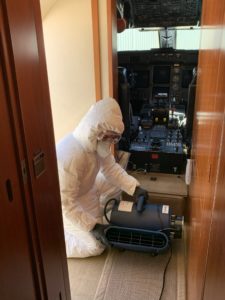
Although these are good habits to get into, the inside of FBOs and airports shouldn’t be the sole focus of the new cleaning regimes companies have incorporated. “It’s not just spaces inside that should be decontaminated, but equipment from planes too,” states Karitonas.
According to Karitonas, unlike manual cleaning automated decontamination technology can eradicate viral pathogens: “Both hydrogen peroxide vapor [HPV] and ultraviolet-C [UV-C] light decontamination technologies have the power to completely decontaminate a space and eliminate the virus.
“HPV and UV-C light decontamination are both proven options, demonstrated to reduce micro-organisms much more resistant than SARS-CoV-2 to safe, non-infective levels. By understanding what the potential infection risks are, cleaning staff and cabin crew can plan steps to tackle them and minimize the likelihood of transmission.”
Karitonas believes that to ensure areas such as toilets, door handles, seats and counters remain Covid-secure there is a need for an increase in manual cleaning in FBOs and private airports, as well as the introduction of regular decontamination services to reduce gaps that natural and unavoidable human error will cause.
“UV-C light technology can be particularly useful for high footfall environments that require regular, fast decontamination and is already used by hospital hygiene professionals to rapidly decontaminate sluices, storage areas and waiting rooms.
“The technology works by filling an area with UV-C light. This breaks down the lipid outer layer of the organism and destroying the genetic material within it. As a result, it can decontaminate spaces and reduce pathogens by up to 99.99%. “Staff using UV-C light technology should use a trusted approach with built-in validation so they can be sure effective decontamination has taken place, rather than assuming the process has gone as expected,” he adds.
Changing infrastructure
It’s not just the cleaning procedures that have changed due to Coronavirus. The infrastructure of some FBOs and airports have been substantially altered to account for the new way of traveling.
“Milano Prime at both Linate and Malpensa have been among the first FBOs to implement infrastructure changes before standards and rules had been announced by European and local authorities,” says Dorigotti.
“Key infrastructure changes include the physical separation of flows, thermal scanners to measure temperatures of those accessing the terminals, shielding screens in common areas, concierge, security and authorities’ desks to further limit contacts and maintain social distancing.
“As an airport manager, we will keep providing safe travel and operations for passengers, operators and employees with health control measures likely to become permanent in the years to come.”
“Touchless fever detection and mask detection technology will become one of the key safety measures at all entry points,” comments Vinod Bijlani, artificial intelligence and internet of things practice lead, Hewlett Packard Enterprises. “Combining thermal imaging with video analytics and AI techniques provides a robust system to identify individuals, their body temperature and whether they are wearing masks.
“Skin temperature as measured by thermal cameras is not always an accurate indicator of body temperature. As an example, the skin temperature of passengers alighting from air-conditioned cars is lower than their actual body temperature. Immediate temperature screening would result in inaccurate readings that may fail to identify a fever. To enhance fever detection, facial and skin temperature data is sent to AI models which track temperature information and any anomaly with historical data is flagged,” says Bijlani.
“While thermal scanners may not be the ultimate defense, the screening is a basic step toward safety. Researchers are working on breathalyzer tests which can detect Covid-19 and other viruses. This has a potential of becoming the game changer. Breathonix, a spin-off company from the National University of Singapore, has developed an easy-to-use breath test to detect Covid-19 within a minute.”
London Biggin Hill Airport has opened a Covid-19 testing center on site, available to all arriving and departing passengers. The Mansi Testing Suite offers four different types of test provided by G16, a highly experienced Covid-19 testing organization. These include PCR (Polymerase Chain Reaction) Testing, LAMP
(Loop-mediated Isothermal Amplification) testing, antigen testing and antibody testing. Results are available in as quickly as 15 minutes, depending which type is selected.
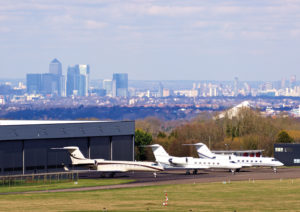
has been one of the first airports in the UK to introduce its own testing centre on site
“The Mansi Testing Suite is an extension of our contactless travel initiative, giving passengers and crew a convenient way to be tested so they can continue their journey with peace of mind,” says Andy Patsalides, head of marketing at London Biggin Hill Airport. “Passengers can either be tested at the Mansi Suite, or clinicians will come airside to conduct tests on board the aircraft or in the terminal building.”
Milano Prime has also factored in in-house testing as part of its new infrastructure. “We have recently signed a partnership with Gruppo San Donato, the Italian hospital group, offering Milano Prime’s customers and operators with nose-pharyngeal swabs in private regime for the detection of the SARS COV-2 virus,” says Dorigotti. “The swabs can be performed at Milano Prime Terminals at both Linate and at Malpensa at one’s permanent or temporary domicile, including hotels, in Milan and its province. The service has been well received and used by our customers since its launch.”
With visible changes appearing throughout private airports and FBOs, it could be assumed that the luxurious and exclusive feel that these places once had may have disappeared for some customers. Cutshall disagrees: “Customers have welcomed the additional precautions we are taking and expressed their gratitude for our pro-active approach. We encourage customers to bypass the FBO lobby and ride in their preferred ground transportation plane-side to further reduce touch points.”
Dorigotti says, “Passengers and operators require the safest travel experience for their own peace of mind. Technology and processes can be of great help to this end — thermal scanners, paperless documentation, automated monitoring of sanitization measures all help to provide a contactless and seamless experience for passengers.”
“FBOs could use AI-based systems to analyze current and historical occupancy information to plan optimal cleaning routines without interfering with the VIP experience of their guests,” says Bijlani. “I see a possible surge in advanced robotic applications for sanitation, where a robot would either use electrostatic spray nozzles to disperse disinfectants more widely and evenly on critical surfaces or be equipped with UV-C light powerful enough to irradiate and destroy microbes such as bacteria and viruses. Such a decontamination routine could be carried out with minimal disruption to the atmosphere in FBOs.”
“Business aviation has shown a recovery trend thanks to the increasing demand of existing customers and a meaningful number of first-time business aviation flyers. The sector has proven its resilience and importance in providing essential services and in allowing traveling throughout 2020,” concludes Dorigotti.
Despite the various changes that are already in place, and the many more that are no doubt on the horizon, FBO users and managers are happy with the way things are progressing and are looking forward to a time when traveling feels more normal again, but until then it is clear that business aviation will do whatever it takes to keep aircraft in the sky.


